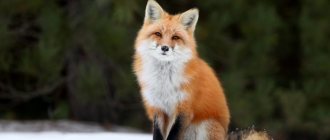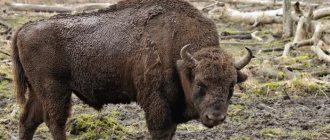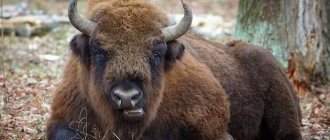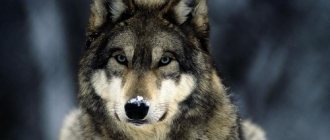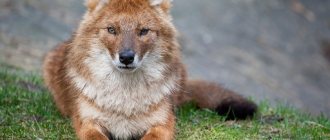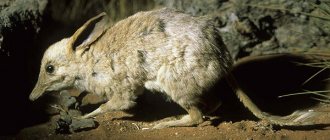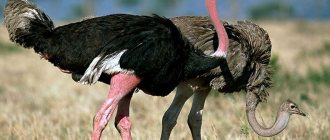- Encyclopedia
- Animals
- Wolf
Wolves are predatory animals from the canine family. They look very similar to dogs, because they are their ancestors. The color of wolves depends on the area where they live. Mostly gray with a reddish tint, the fur is thick and long, the teeth and fangs are very sharp, the weight sometimes reaches 80 kilograms. On average they live about 15 years.
Where do they live and what do they eat?
Wolves live in Europe, Asia, and North America in different landscapes, preferably in steppes, forests, forest-steppes, and tundra. But they do not like dense forests. But people can settle near their homes, especially if livestock is raised there. They settle in families, or even in packs, in a certain area, which they then consider theirs, mark and do not violate these boundaries.
Wolves feed on animals that are weaker than them, both large and small (hares, mice). Small animals are usually hunted by solitary wolves. Wolves also hunt domestic animals.
Wolves are very intelligent animals. They understand many commands by howling. Their howls vary, thanks to this they communicate with other packs, or look for a wolf that has lagged behind the pack. The howl-cry is emitted by the leader when it needs to pounce on prey.
Wolves are very kind to their offspring. During the mating season, they can fight for the she-wolf, but when her cubs are born in the spring, they take care of them by bringing food. The mother wolf feeds the wolf cubs with her milk for about two weeks and is inseparable from them, warming them with her body. And the father wolf gets food, and other wolves from the pack help him in this. In the summer, wolf cubs are fed animal food, and in the fall they are taught to hunt and to a nomadic lifestyle.
It is interesting that in winter a pack of wolves follows the leader trail after trail, without leaving extra traces for safety reasons. They are friendly with each other and in a flock they share the prey equally, and they also survive the winter cold together.
Should you be afraid of meeting a wolf?
Wolves are nocturnal animals. They hunt mainly at night, and during the day they rest in their shelters. But cases are different, and if you encounter a wolf during the day, you don’t need to be afraid of it, but boldly, without unnecessary movements, walk away. If the wolf is not hungry, he will not touch you. Meeting a pack is another matter. Such a meeting is dangerous and it is better not to meet with them.
What benefits and harms do they bring?
Of course, wolves cause a lot of harm, destroying domestic animals, as well as nests with bird eggs in the forest. But, definitely, they bring great benefit to the forest, because they clear it of sick animals that bring disease, and also sometimes feed on carrion, protecting forest inhabitants from disease epidemics. These forest orderlies, as they are called, also regulate the number of animal species.
Wolf: general characteristics
Wolves represent a group of predatory mammals and are part of the canine family. They belong to the genus of wolves, which also includes jackals and coyotes.
Most representatives of the wolf family are very large animals, their height reaches 90 cm, and their weight ranges from 50 to 80 kg. But among them there are also smaller varieties, with a height of 50 cm and a body weight of 13-22 kg.
Wolves are large, strong and beautiful predators
Wolves of northern latitudes have dense fur with a thick undercoat, thanks to which they can easily endure severe winters. Predators living in areas with warm climates have shorter fur. The most common color of these animals is gray or brownish-brown, but there are representatives with pure white and red-red coat color.
Wolves are considered cruel and bloodthirsty, but in fact they pose a danger to humans only in case of hunger, or when their life is threatened. Wolves just don’t attack, and generally avoid meeting people.
These are very smart, dexterous and skilled hunters who use different tactics to drive in game. Wolves are hardy and very fast, and can accelerate to a speed of 40 km per hour in a couple of seconds. During the night they are able to cover distances of up to 60-80 km.
These predators have extremely acute hearing and an incredibly sensitive sense of smell. Their vision is less developed, and they see the world in dull, grayish tones. When searching for prey and hunting, wolves rely on their sense of smell, and can smell potential prey at a distance of up to 3 km.
The lifespan of wolves in the wild is 10-15 years; in captivity, their lifespan is approximately the same.
Elena
Ask a Question
Question to the expert
Why is the wolf called the forest orderly?
Wolves received this nickname because they primarily kill weak and sick animals, preventing the spread of pestilence among ungulates. These predators play a very important role in the forest ecosystem. It has long been proven that where they are exterminated, herbivores die en masse from deadly epidemics.
How many animal powers can one person have?
Regarding the question about the number of totems and power animals, I believe that a person still has one totem animal. The one that most reflects his character, and the one that leads him along the path of development.
However, our unconscious is connected to the energies of all animals, to one degree or another. Therefore, it is very natural that we can connect to other totems. This is especially useful for mastering patterns of behavior that were not characteristic of us before, expanding the range of actions.
For example, I have one personal totem, and I interact with the others as power animals. However, the names are not so important; they are rather symbols for convenience. The principle of interaction in both cases is practically the same.
So….
Habitat
In ancient times, wolves could be found in almost all corners of the globe. But due to uncontrolled extermination by people and the reduction of their natural habitats, the range of gray predators has decreased significantly, and in some countries they have been completely exterminated.
Currently, wolves are found in the following natural areas:
- Eastern part of Europe: Russia, Ukraine, Poland, Belarus;
- Baltic countries;
- Balkan Peninsula;
- Scandinavia;
- The Iberian Peninsula;
- Western Asia: Georgia, Azerbaijan, Armenia;
- Central Asian countries: Kyrgyzstan, Kazakhstan, Afghanistan;
- Northern part of the Arabian Peninsula;
- Iran and Iraq;
- Korea;
- Hindustan Peninsula;
- North America (from Alaska to Mexico).
- South America (Brazil and Paraguay only).
Wolves perfectly adapt to any conditions, so they inhabit both dense, impenetrable forests and high mountain regions. But at the same time, predators prefer areas with rugged terrain, plains and meadow areas with sparse undergrowth.
In general, gray animals live sedentary lives, but when herds of ungulates migrate, they follow herbivores, moving hundreds of kilometers away from home. And wolves living in the steppes wander behind herds of domesticated deer and flocks of goats and sheep.
What do wolves eat in the wild?
What can wolves, which are true predators, eat? Of course, their main diet consists of meat, and wolves do not disdain anyone, neither herbivores, nor birds, nor small rodents. These animals also eat reptiles and beetles, and never miss the opportunity to feast on bird eggs. Their menu also includes carrion, and wolves often take prey from other predators.
In the summer, forest orderlies eat fresh berries and fruits. Surprisingly, wolves are very fond of melons and melons, and even raid melons to treat themselves to a juicy watermelon or melon. Moreover, the animals gnaw all the fruits until they find the ripest and sweetest.
Who do wolves hunt?
Almost all animals that share their habitat become the objects of hunting for these predators. The wolves' menu includes:
Recommended by topic
Fox Panda Lynx
- Large herbivores: elk, deer, bison;
- Roe deer, saigas, antelopes;
- Wild boars;
- Martens, foxes, raccoons, beavers;
- Hares, muskrats;
- Small rodents: gophers, jerboas, field mice, wild hamsters;
- Birds, for example, black grouse, wood grouse, pheasants, ducks.
Wolves living in coastal areas eat seal carcasses washed ashore, and they will not refuse fish. Well, in unfavorable periods, predators feed on everything they can get, including lizards, frogs, various beetles and locusts.
The wolves' menu is dominated by meat dishes.
During particularly severe and cold winters, animals suffering from hunger even attack adult bears. Yes, some wolves die in a fierce battle with the powerful owner of the taiga, but a bear is unable to fight off a hungry pack. So the rest of the pack, thanks to the dedication of their comrades, get the opportunity to get enough.
Wolf hunting methods
Forest predators have several hunting techniques in their arsenal, the use of which depends on many factors. For example, wolves understand perfectly well that they can only cope with a huge bison or elk as part of a pack, so they never attack such large prey alone.
When choosing tactics, animals also focus on weather conditions and landscape features. Animals will not hunt deer or roe deer on open plains, knowing that they simply cannot keep up with the fleet-footed herbivores. And finally, wolves know how to be patient, and are able to pursue the intended object for several days in order to seize the most favorable moment for an attack.
A pack of wolves overtook a deer
When hunting a herd of deer, predators use a favorite technique that has been perfected over centuries: a drive of prey, during which they identify a potential victim. Usually, wolves choose weak and sick animals or cubs, but with a great superiority of their strength they can also target an adult.
These animals have such a developed collective mind that, without even talking to each other, they change tactics on the fly, while continuing to act as a single organism.
Wolves know that the key to a successful hunt is well-coordinated teamwork. Each member of the pack has their own duties, which they strictly adhere to. Lighter and faster she-wolves are responsible for wearing down prey by chasing the herd and constantly making feint attacks. The task of young males is to outflank the herbivores and rush across the frightened animals. Well, wolf warriors attack the chosen target with lightning speed.
Hunting
Wolves on the hunt
Wolf hunting is a complex system of techniques that wolves perfect throughout their lives. The pack hunts down the prey. He clearly calculates her strength and his own. Distributes roles during the drive and attack and, of course, takes into account a strict hierarchy when distributing prey. Chasing prey, wolves organize organized raids. The leader and assistant lie on the intended path of the victim. The beaters come from the rear, surrounding the prey. A large animal is starved to death. Changing each other, they pursue until exhaustion and attack.
Lifestyle of wolves
Wolves are nocturnal predators and their activity occurs in the dark. Forest animals live in packs, the size of which depends on the conditions of their natural habitat and the amount of food. On average, a wolf clan consists of 5-12 members, in rare cases their number can reach up to 25 individuals. Each flock occupies a personal territory, ranging from 50 to 1000 km2, and the size of their territory is determined by the region of habitat.
Usually, a wolf clan is formed from close relatives, but sometimes a pack decides to accept members of other families or lone wolves into its ranks.
Lifestyle of a wolf pack
Forest predators have a very complex social structure. There is a strict hierarchy in their team; each wolf has its own status and certain responsibilities. And at the same time, all members of the family observe the main rule - the interests of the pack are above all! In the wolf clan there is no place for personal desires, greed, greed and self-interest. The animals understand very well that their strength lies in unity and cohesion, so they strictly adhere to their laws.
The wolf pack has its own laws and rules
At the head of each pack is an alpha male, on whose shoulders lies responsibility for the well-being of the entire clan. It is the leader who makes all the key decisions regarding hunting, recreation, and declaring war on another clan. The alpha male has the right to expel or even kill the offending relative, and the fate of the incoming wolf depends on him - whether he will become a member of the family, or he will have to leave. In addition to his responsibilities, the leader also has some privileges, for example, he owns the best pieces of the spoils.
The alpha male is neither a tyrant nor a despot, but a wise and reasonable wolf who never abuses his unlimited power. He treats all members of his clan with equal friendliness, listens to their opinions, and in case of food shortage, shares his piece with young puppies, realizing that they are the future of the whole pack.
If the head of the pack has a female, then she occupies the next level of the hierarchy. The she-wolf dominates all females, and, if necessary, temporarily performs the duties of her spouse. The “First Lady” also keeps order in the clan and gives permission to other she-wolves to reproduce.
Recommended by topic
Ferret (ferret) Seagulls Pelicans
Many alpha males have successors who, after their death, become pack leaders. As a rule, this role goes to the leader's brother or his eldest son. A separate caste are adults, strong individuals of both sexes; they are the backbone of the military army, and are responsible for driving and capturing prey, and are also indispensable in battles with another pack. Female mothers are responsible for raising their offspring, and their task is also to monitor the safety of the cubs while the rest of the pack is hunting.
And finally, the most striking point that distinguishes wolves from all predators is that they take care of old or infirm wolves. Members of the clan who were injured while hunting or in battle with their fellow tribesmen, and wolves who reached old age, have the right to protection and food. True, when it comes to the survival of a flock, for example, during a famine or a raid by hunters, weak individuals become ballast. And according to the cruel wolf rules, useless family members are simply abandoned or, worst of all, sometimes even eaten.
Lone wolves
These animals have a very strong emotional attachment to their pack, so why do some animals prefer bitter loneliness? And the reasons can be completely different. Some wolves have strong leadership abilities, and since the place of the leader is unshakable, they voluntarily leave in order to eventually create their own clan.
Lone wolves have a hard time surviving in the wild
Sometimes, the wolf simply does not want to show unquestioning submission to the alpha male, and is forced to leave the pack, otherwise he will die for disobedience. Voluntary exile is also chosen by those predators who, for inexplicable reasons, are disliked by all members of the family, and demonstrate their contempt to him in every possible way.
In some cases, young males and females become lone wolves who do not want to join the pack, but prefer a life full of dangers, but free. Also, wolves who have lost their soulmate and now cannot find a suitable place for themselves in this cruel and merciless world can choose a solitary existence.
Character and habits
Most animals, whether predators or herbivores, live by primitive instincts: to eat, give birth, and survive on this not very hospitable planet. But wolves are extremely multifaceted and interesting creatures, with a deep inner world and a vulnerable soul.
Wolves do not tolerate betrayal and betrayal
Forest predators know how to love, remaining faithful to their partner until their last breath. They do not forgive betrayal and betrayal. Wolves know firsthand what friendship is, and value qualities such as loyalty and honesty in their relatives. These animals have courage, courage and nobility, and are ready to sacrifice their lives for the well-being of the entire pack. And finally, they are capable of such burning hatred that they will do anything for the sake of revenge, even certain death.
Already at a young age, the individual character of wolf cubs clearly manifests itself. Some of them are calm and reasonable, others have traits such as impudence and impatience, and still others have innate leadership abilities. And it is the wolf’s temperament that determines what rank he will occupy in the clan. These animals have an innate sense of belonging to the pack, they show loyalty to the leader and respect mature, as people say, “seasoned” wolves, who pass on all their experience to the younger generation.
Although forest predators have to constantly fight for survival, they find time for games and pranks. Not only young wolf cubs and juveniles love to play; adult wolves are also not averse to frolicking. After a successful hunt, when the entire clan has plenty of food, the animals arrange fun and noisy entertainment, which only strengthens friendly relations between members of the pack.
Wolves love to play and have fun.
Entire poems can be written about wolf love. Gray predators are monogamous, that is, they choose a partner for themselves for life, and the phrase “until death do us part” is not an empty phrase for these animals. Their family ties are not based on passion and the need for reproduction alone; a connection is formed between a pair of wolves at the highest mental level. As soon as animals meet their soulmate, they are no longer interested in other members of the opposite sex, and remain faithful to each other, both physically and spiritually.
There are many confirmed facts about how wolves remained near their partner who was caught in a trap or shot by hunters. Some predators are so attached to their chosen one that after his death they consciously go out to human settlements, as if they were looking for death and oblivion. Most wolves continue to live after the loss of their love, but they no longer enter into marriage relationships, preferring to remain alone forever.
And of course, one cannot fail to mention such a phenomenon as wolf revenge. These animals sometimes cause great harm to farmers, attacking villages and slaughtering livestock. Usually, this happens during harsh winters, when predators have to starve due to a catastrophic lack of game in the forests. But this is not the only reason. Sometimes wolves deliberately choose a populated area and cause real mayhem in it, indiscriminately killing everyone who meets them on the way. And all because the animals are taking revenge on the hunter living there, who killed their relatives or, even worse, newborn wolf cubs. The animals invisibly follow this man all the way to his house, and a few days later, under the cover of darkness, they sneak into the village to commit blood retribution.
Poll: Some people keep wolves as pets. Would you like such a pet?
Of course yes, I have always been fascinated by these beautiful and proud predators!
33.33%
Yes, it would be interesting to walk down the street with a real wolf.
16.67%
No, these are not domestic animals, but wild animals, they are unpredictable.
41.67%
No, I don’t like dogs at all, and especially wolves.
8.33%
Voted: 24
Reproduction and raising of offspring
Sexual maturity in forest predators occurs when they reach 2 years of age. But, given the fact that wolves form long-lasting married couples, and at the same time choose a life partner for a long time, their first offspring appears no earlier than they are 3-4 years old.
Some wolves never become parents at all, because they could not find a suitable partner for themselves, and casual sex is not typical for them. Such lonely predators live on their own, or join some kind of pack, joining the ranks of warriors.
In wolves, the breeding season occurs only once a year and is strictly seasonal. Mating games of gray predators begin in January and last until March, so the birth of cubs occurs in favorable warm months, when the forests are full of game.
Features of the mating season
A peaceful and calm environment usually reigns in a wolf pack, but with the onset of mating season, tension increases in the clan of predators. The dominant pair fiercely protects each other from other family members and lone wolves. If there are already married couples in the pack, they also have to protect their partner from the attacks of their rivals. Well, predators who have not yet acquired their own pair are actively starting to search for their soul mate.
Couple of wolves in love
Wolves, on an intuitive level, avoid sexual relations with their close relatives, therefore individuals from the same brood never enter into a marriage union with their brothers and sisters. In most cases, young wolves generally look for a permanent partner among members of other packs.
There are many more males among wolves, so for one free she-wolf, from 2 to 5 suitors apply. An honorary escort of gray admirers gathers near young females and mature females (including widowed she-wolves), but not everyone has a chance to get a lady of their heart. Of course, males have to fight among themselves, and sometimes their fights are so fierce that they end in the death of one of the rivals. And what’s most interesting is that there is no guarantee that the winner will get the she-wolf. After all, the final decision remains with the female, and if she doesn’t like the gentleman, she won’t let him get close to her.
And when the knightly tournaments and brutal fights are over, wolf couples in love begin to look for a secluded place to be alone and find a safe lair for their heirs. From this moment until the birth itself, the male gallantly looks after his chosen one, not hesitating to express his feelings for her with affectionate touches and romantic “serenades”. As soon as the she-wolf becomes pregnant, the future father becomes even more caring and protects her from any threat. Well, the female responds to her husband with the same love, tenderness and devotion, and tries to spend all her free time with him, because after the babies are born, her attention will belong exclusively to the newborn wolf cubs.
Natural enemies of wolves
Many large predators live in the neighborhood of wolves, including bears and wild felines. But few of them risk getting involved with such a formidable and powerful force as a wolf pack. Therefore, wolves have no enemies among other forest inhabitants; they rather have competitors for prey.
None of the forest inhabitants would risk crossing the path of a wolf pack.
Clashes between gray animals and other animals sometimes occur over the division of hunting trophies. Moreover, it is the wolves, using their numerical superiority, who take food from their four-legged neighbors. For example, lynxes and pumas often have to yield to them the carcass of a freshly killed herbivore. If huge cats can easily cope with one wolf, then they have no chance against a hungry pack.
Only one predator poses a real threat to wolves - the Ussuri tiger. Striped cats even deliberately hunt them, although they choose lone wolves or individuals straying from the pack as their prey. But the cunning tiger avoids meeting with an entire wolf clan, knowing full well that he will not emerge victorious from such a fight.
In the wild, wolves' main enemies are other wolves, especially during periods of hunger. In favorable times, these predators do not encroach on each other’s hunting grounds, but when there is an acute shortage of food, fierce battles for territory occur between packs. When it comes to survival, wolves are merciless to their fellow tribesmen, and when two opposing camps meet, about a third of the animals on each side die.
Well, the main enemy of the wolf was and remains man. In ancient times, people mercilessly destroyed these animals, considering them accomplices of the devil. The times of superstitions and ridiculous prejudices are in the past, but people continue to hunt gray predators. And the worst thing is that hunters kill wolves for fun, just to show off to their friends a valuable trophy in the form of a wolf skin.
Behavior
The wolf is an animal with complex behavior, loyal to its relatives. A large predator whose existence depends on mutual assistance within the pack.
A pack is not a random gathering of hunters, but a family with close family ties. Everyone is connected by caring for each other and a common goal. It shows a clear social structure:
- below - young litter - puppies up to 1 year;
- slightly higher are one-year-old teenagers. They take care of the young;
- the next level is three-year-old wolves. They form the backbone of the pack, a fighting unit capable of coordinating actions on the hunt;
- at the top is the dominant couple. These are parents of all generations. They have a dominant position.
